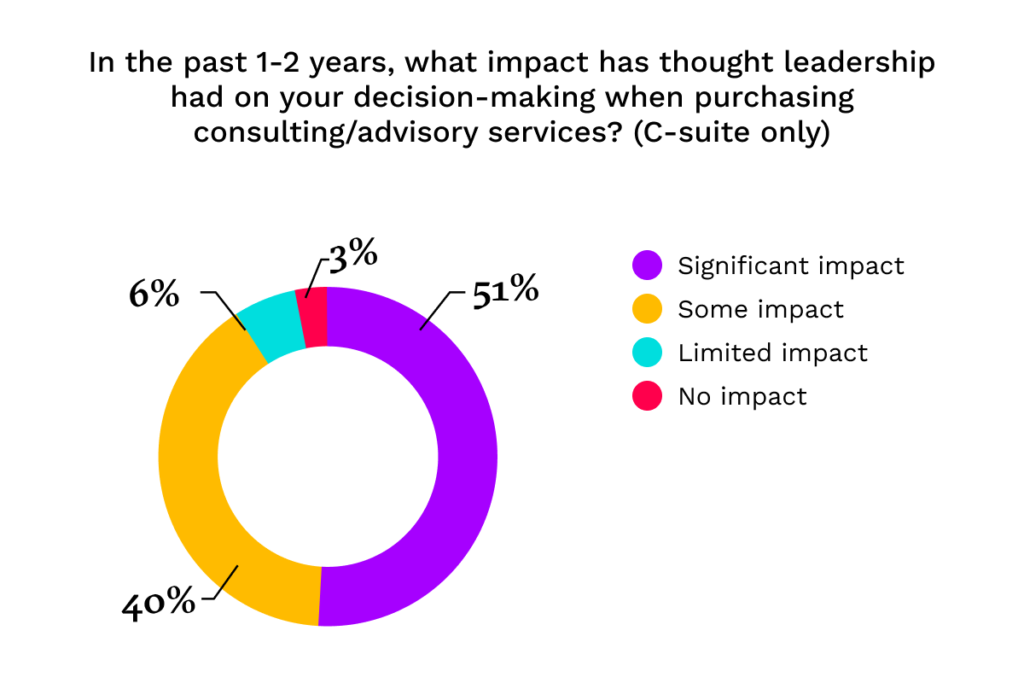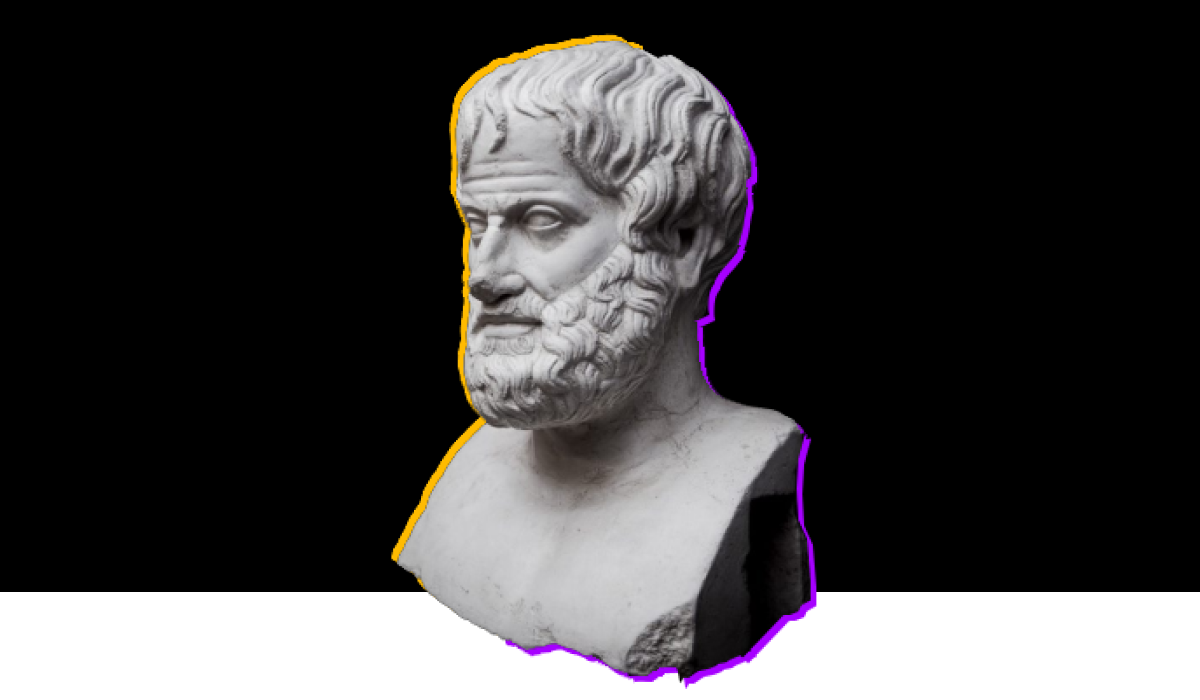Marketing, in all its guises, is a form of persuasion.
Having wrestled with this reality over many years, I have reached a place of acceptance. We’re trying to influence others to see the world in a certain way or to regard products, services, and experiences from a positive perspective. By extension, persuasion must therefore be the raison d’etre of thought leadership—to convince decision-makers that a topic or a theme really matters, that they must act upon it for their own good (with a degree of urgency), and that our firm is the only firm that has the requisite skills, expertise, and credibility to help them address it.
On the whole, this persuasion appears to be working. In our most recent Client Perception Study of over 3,000 buyers of professional services (January 2023), over 90% of C-suite executives from across the Americas, APAC, and EMEA said that thought leadership had a significant, or at least some, impact on their decision when purchasing professional services. Over 50% said it had a significant impact on their decision, rising to 70% for executives from the US.

What is it that effective thought leadership has that makes it so persuasive? Can we distil these qualities and bottle them in some way? The Source ratings methodology is certainly a proven way to do this, assessing materials on 15 dimensions under four quality pillars: Differentiation, appeal, resilience, and prompting action. But it appears that one of the earliest thought leaders may have got there first, and the parallels are rather striking.
Leafing through the Sunday newspapers a week or so ago, I saw a brief reference to the Aristotelian triad, which caught my attention among my morning of tea, cake, and Sky Sports football. It turns out that in the 4th century BCE, Aristotle had a penchant for persuasion. As a philosopher, he was naturally interested in how best to land ideas and win over audiences. Similar to the “Talk like TED” presentation techniques of today, he identified some core strategies that seemed to build persuasiveness in rhetoric. The Aristotelian Triad of logos, pathos, and ethos (plus kairos) turns out to be more than a useful sense check for any thought leadership author looking to persuade senior executives to act.

Let’s look at each appeal in turn, in the context of current trends and issues in the thought leadership space.
Logos – an appeal based on logic
Logos is an appeal based on rational, objective evidence, and data. To persuade others based on a solid argument, grounded in facts.
We know from interviewing a wide range of senior leaders each year that they really lean into thought leadership when they need to persuade their own stakeholders, to build consensus, secure investment, or agree a new direction in the business. The materials that work best in this context are evidence based, and many a data point from professional services firms is borrowed for key presentations and board papers.
In the Source world, one of our core dimensions, when looking at thought leadership, is resilience— which evaluates the substance, data, and method behind a report, and to stretch the Greek theme a little further, resilience is most commonly a firm’s Achilles heel. Materials based on lightweight research or that are more opinion-based or barely disguised sales propositions will always struggle to appeal based on logos. Over the years, we’ve noted that the firms that have made really positive moves in our benchmarking studies have typically been very intentional about building in greater resilience or logos to their output.
Pathos – an appeal based on emotions
While B2B decision-makers are sometimes portrayed as cold and methodical, the reality is very different. B2B decisions are often emotionally charged due to the stakes being very high. Mistakes can be costly, not just in profit and loss terms, but in career terms. While evaluation criteria from procurement teams appear clean and objective, decision-making units will be subject to more human drives and instincts than meets the eye.
The emotional play in thought leadership arguably operates at three levels. First, most simply, is the material engaging and does it provide a positive user experience? This aspect closely aligns with Source’s appeal dimension.
Second, to persuade decision-makers that an issue or topic is of sufficient importance or strategic relevance that they need to act, and ideally with some degree of urgency. In this case, persuasive thought leadership needs to raise the stakes in response to a risk or dial up a sense of FOMO with respect to a new emerging opportunity. Third, to persuade decision-makers that your firm is the best firm to help the client to mitigate the risk or exploit the opportunity. Perhaps more professional services choices are driven by risk-aversion (“Nobody ever got fired for buying IBM” etc.) and the job for thought leadership is to convey a sense of authority and reassurance on behalf of the publishing firm.
The most engaging thought leadership often plays the pathos card by blending more human, real-world stories along with charts and data points. Stories from clients, experts, or influencers help to bring ideas, capabilities, and impact to life and keep the audience engaged. It’s no surprise that Microsoft employs a Chief Storyteller (Steve Clayton), to move beyond what the technologies can do into the impact that it can have in the world—a far more persuasive approach. Investments in high-end, dramatic, and emotive imagery can also help stories and examples to hit the mark.
Over the last two years, our research has observed a significant growth of video in thought leadership production and activation, and pathos may well be an underlying driver here as well. Arguably, video formats create more opportunity to persuade and influence than the humble pdf by leveraging the power of emotive rhetoric from relevant experts.
Finally, one megatrend in thought leadership that must be linked to pathos is the growing extension of thought leadership content into more experiential opportunities. Investments in labs, innovative spaces, and collaborative formats create opportunities to build a different level of engagement and relationship with senior audiences, leaning into an appeal based on pathos.
Ethos – an appeal based on credibility
The word ethos comes from the Greek word for character, and this appeal is based on who the speaker or author is. Persuasion is built upon the credibility, specialisation, and authority of the person or persons creating the thought leadership. Earlier, we referred to resilience and the importance of objective evidence, facts, and data but excellent qualitative data and smartly crafted arguments from credible experts can be highly persuasive even without quantitative back-up.
This dimension is baked into the Source evaluation framework, but it is often missed in thought leadership outputs. Frequently, authors are not named at all, or if they are, little is said about their credibility or authority on the subject matter. This gets noticed by senior stakeholders much more than you would think.
One specific tripwire we observe is when external copywriters or journalists are used to feed the content machine, and the cited authors are either external or anonymous, immediately diluting the relationship between the material and the firm. At extremes, such thought leadership can look, feel, and read like it has been outsourced—which undermines the core goal, to persuade audiences about the authority and credibility of the firm.
An appeal based on ethos is also in evidence when we see high-performing firms leveraging their CEOs and other senior leaders through social media channels. Having top executives share and comment on the firm’s key thought leadership outputs can generate significant buzz and reach in the market.
Kairos – an appeal based on context and timing
While kairos is not seen to be part of the triad of persuasion, it was part of Aristotle’s teachings and has real resonance with thought leadership development. Kairos relates to the importance of timing and context in persuasion. An effective argument needs to be made at the right time to the right audience in the right setting, otherwise it’s wasted.
Having real clarity around the intended audience for thought leadership often makes a huge difference in quality terms, from the sharpness of the central proposition for the piece through to the specificity of recommendations and take-aways. This also links to the growing use of personas and “voice of the client” research for thought leadership, to ensure outputs are grounded in relevant insights about the client context—their needs, issues, and jobs to be done at a particular moment in time.
Timing for thought leadership is an interesting consideration and most of our research with senior executives suggests the highest value is created when content talks to what’s next or what’s around the next corner, typically viewed as the next 18-36 months. Too much thought leadership misses this window and ends up as “me-too” material that just covers familiar ground. Consequently, many firms are focused on how to become more agile and faster to market with ideas and thinking to keep relevance high. Long and slow thought leadership development cycles are no longer suited to a fast moving, dynamic, and uncertain market.
The Aristotelian thought leadership checklist
- Is your central argument supported by facts, data, and evidence? [logos]
- Does it contain emotive as well as rational elements? [pathos]
- Have you established the credibility of authors and leveraged your key influencers? [ethos]
- Are you engaging the right audience at the right time? [kairos]